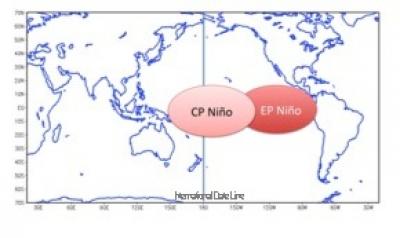Earth warms weaken El Nino's function to prevent storms
According to an article published in Nature, the circulation of the El Nino phenomenon in the eastern Pacific is seen as a shield to protect the US and the Caribbean from terrible storms that may be weak. going by the influence of its brother in the central Pacific region is gradually strengthening due to global warming.
"There are two EL Nino phenomena," says Ben Kirtma, professor of oceanography and oceanography and author of the study of the El Nino phenomenon from the Miami's Rosenstein School's Department of Oceanic and Atmospheric Sciences . A phenomenon in the eastern Pacific that we already know and that El Nino is strengthening in the central Pacific region. '
El Nino is a hot water area circulating along the equator of the Pacific region, affecting climate circulation in tropical and equatorial regions. The El Nino phenomenon in the eastern region deflects the winds of the Atlantic region and may be the main cause of storms in this region. The El Nino phenomenon in the central Pacific region, near International Dateline is believed to be the cause of drought in Australia and India as well as reducing the beneficial effects of the El Nino phenomenon on the eastern region.
The team of scientists led by Sang - Wook Yed from the Korea Ocean Research and Development Institute used data on the temperature of the Pacific sea surface collected from 150 Last year to analyze 11 global warming phenomena recorded by the Intergovernmental Panel on Climate Change (Intergovernmental Panel on Climate Change). Eight of the phenomenal studies show that global warming will continue to affect the El Nino phenomenon in the central Pacific region.According to these data, over the past 20 years, the El Nino phenomenon has occurred more frequently in the central Pacific region. The cycle of El Nino is once every 5 years and more than half of all El Nino phenomena have such cycles.

(Photo: Ben Kirtman / UM)
Yeh said: 'The results from this study indicate that the El Nino phenomenon can significantly affect the earth's climate as the earth gets warmer'.
Although the centers of the central El Nino phenomenon of the Pacific Ocean are approximately 4100 miles from the center of the eastern El Nino, the El Nino phenomenon still occurs in parallel in both places. The increase of the El Nino phenomenon in the central region may impair the storm barrier function of the El Nino phenomenon in the eastern Pacific.
Professor Kirtman said: 'Currently we are just witnessing the development to the middle of the El Nino phenomenon in the eastern Pacific. That's why we see such violent storms in the Atlantic Ocean. Due to this phenomenon, we also witness that South America has a relatively wet winter while the northeast is dry and warm. '
Professor Kirtman hopes that the El Nino phenomenon is expected to cause a major Atlantic storm in the 2010 hurricane season to end next spring after the La Nina phenomenon ends.
Growing up in Southern California, Professor Kirtman was often the one who had to pump water from his floor during the rainy season, which he later discovered was caused by the El Nino phenomenon.
'Ultimately, we know how current sea currents work and how sea level rise in temperature affects the climate. This also affects each of us including the children who have to control the water pump. My whole career is devoted to studying the El Nino phenomenon because it affects everyone and their lives , 'Professor Kirtman said.
Professor Kirtman has worked with many meteorological organizations around the world to help developing countries deal with extreme weather phenomena.
He said: 'We helped them predict climate change and they used these results to find the most appropriate response.'
- The anger of Earth's mother
- The warming of the Earth increases the intensity of snowstorms
- Typhoon attacks on Southeast Asia are getting stronger
- Climate change increases the risk of cancer
- Earthquakes weaken the earth's crust
- Spray salt into the sky to prevent storms
- The earth warms up badly affecting traffic
- China minimizes greenhouse gas emissions
- A strong hurricane number 10 with level 12 approaches the land
- The device absorbs sunlight to generate electricity, and also shoots excess heat directly into space
- Typhoons move more slowly worldwide
- Do deaths from the sea by the ocean become hotter?
 Is the magnetic North Pole shift dangerous to humanity?
Is the magnetic North Pole shift dangerous to humanity? Washington legalizes the recycling of human bodies into fertilizer
Washington legalizes the recycling of human bodies into fertilizer Lightning stone - the mysterious guest
Lightning stone - the mysterious guest Stunned by the mysterious sunset, strange appearance
Stunned by the mysterious sunset, strange appearance